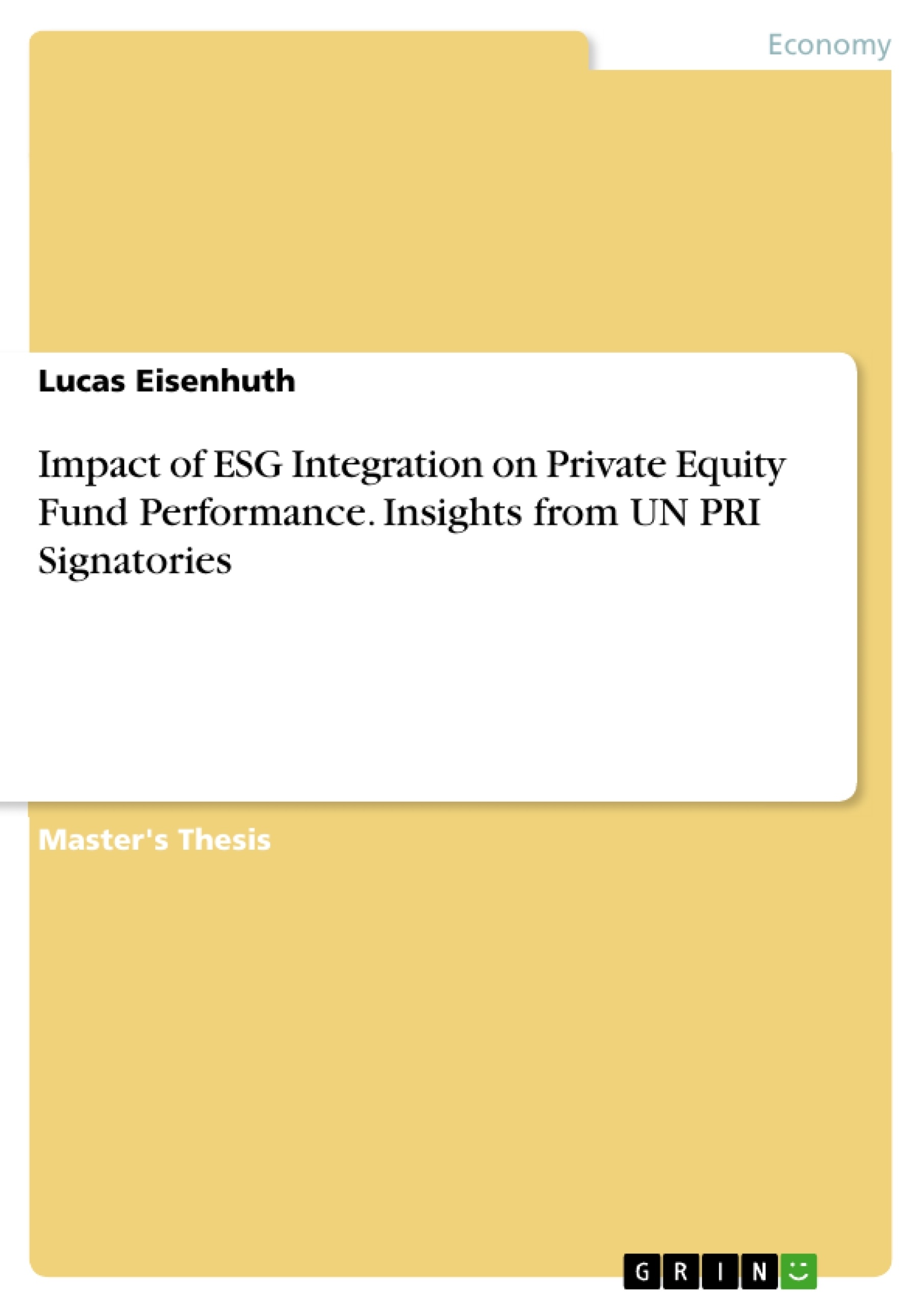This study investigates the impact of environmental, social, and governance integration on private equity fund performance, as measured by the UN Principles of Responsible Investment signatory status of the general partner. Using a comprehensive dataset of 3,127 private equity funds from the Preqin database and ESG information from the UN Principles of Responsible Investment directory, I find that funds managed by fund managers who signed the UN Principles of Responsible Investment exhibit a negative association with financial performance.
Since the 1980s, the private equity (PE) asset class has developed from an alternative investment niche into a major player in the global financial industry. With assets under management (AuM) growth rates that far outstrip most other asset classes, PE plays an increasingly important role. For example, authors from the Harvard Busi-ness Review expect global PE assets to exceed $11tn in 2026 and state that, already today, around 10,000 PE firms are responsible for 20mn employees in approximately 40,000 portfolio companies.
Simultaneously, integrating environmental, social, and governance (ESG) criteria into investment decisions has gained considerable momentum in recent years. Driven by growing awareness of climate change, social ine-qualities, and corporate governance issues, investors increasingly recognize the im-portance of incorporating non-financial factors into their investment analysis and portfo-lio selection. Speaking in numbers, at the beginning of 2020, the total value of sustainable investments across major asset classes in developed markets rose to $35.3tn, representing a growth of 15% between 2018 and 2020. This results in 35.9% of total AuM during this period.
The social relevance of the climate challenge and the associated increasing investment in the sustainable transformation of the global economy has thus logically found its way into the academic world. For example, annual academic publications on environmental finance have grown more than 17-fold, from 13 in 2010 to 223 in 2019. Nevertheless, less than 1% of academic litera-ture on PE or venture capital (VC) between 1960 and 2020 deals with sustainability issues.
Table of Contents
- 1 Introduction
- 2 Theoretical Foundation & Literature Review.
- 2.1 Introduction to Private Equity
- 2.1.1 Definition
- 2.1.2 Organizational Structure
- 2.1.3 Performance Measurements.
- 2.1.4 Historical Returns ..........\n
- 2.2 Sustainability in Finance
- 2.2.1 Definition & Sustainable Finance Concepts
- 2.2.2 ESG Investment Practice......
- 2.2.3 UN Principles of Responsible Investment
- 2.3 Sustainability in Private Equity.
- 2.3.1 Economic Legitimacy and Adoption
- 2.3.2 Motives & Strategic Drivers for ESG Integration...\n
- 2.4 Hypotheses.
- 3 Data & Methodology.
- 3.1 Data Collection & Selection Strategy
- 3.1.1 Fund-Specific Data.......
- 3.1.2 Sustainability Data
- 3.1.3 Limitations
- 3.2 Summary Statistics.
- 3.3 Methodology
- 3.3.1 Performance Effect of ESG Integration
- 3.3.2 Fund Size Interaction Effect...\n
- 3.3.3 Geography Interaction Effect ..........\n
- 4 Results...\n
- 4.1 Performance Effect of ESG Integration
- 4.2 Fund Size Interaction Effect....\n
- 4.3 Geography Interaction Effect..\n
- 5 Conclusion..\n
Objectives and Key Themes
This study aims to investigate the impact of integrating environmental, social, and governance (ESG) considerations into private equity fund performance. The study utilizes data on 3,127 private equity funds from the Preqin database and ESG information from the UN Principles of Responsible Investment directory to assess the association between fund performance and the general partner's signatory status to the UN Principles of Responsible Investment.
- The relationship between ESG integration and private equity fund performance.
- The effect of fund size on the relationship between ESG integration and fund performance.
- The impact of general partner location on the relationship between ESG integration and fund performance.
- The potential trade-off between ESG-compliant investments and financial returns.
- The implications for investors and fund managers regarding investment objectives and risk tolerance when considering ESG-compliant private equity funds.
Chapter Summaries
- Chapter 1: Introduction Provides an overview of the research topic and outlines the study's objectives and methodology.
- Chapter 2: Theoretical Foundation & Literature Review Explores the theoretical foundations of private equity, sustainability in finance, and the integration of ESG considerations within the private equity sector. This chapter reviews relevant literature and provides definitions, concepts, and frameworks related to the study.
- Chapter 3: Data & Methodology Discusses the data collection process and selection criteria, outlining the specific datasets used for the analysis. This chapter also details the methodological approaches employed to examine the relationship between ESG integration and fund performance, including interaction effects.
- Chapter 4: Results Presents the findings of the empirical analysis, examining the statistical significance of the relationship between ESG integration and fund performance, as well as the influence of fund size and general partner location.
Keywords
This study focuses on the intersection of private equity, ESG integration, and financial performance. Key concepts include sustainable investment, UN Principles of Responsible Investment, fund performance, and the potential trade-off between ethical investment and financial returns. This research explores the implications of incorporating ESG considerations into investment decision-making for both investors and fund managers.
- Quote paper
- Lucas Eisenhuth (Author), 2023, Impact of ESG Integration on Private Equity Fund Performance. Insights from UN PRI Signatories, Munich, GRIN Verlag, https://www.grin.com/document/1446592



